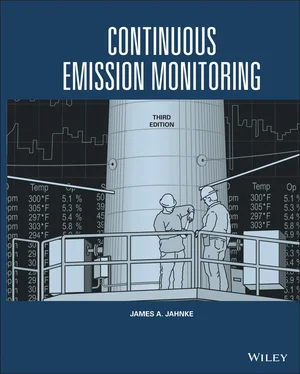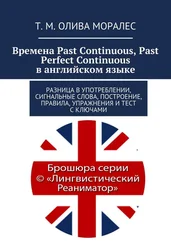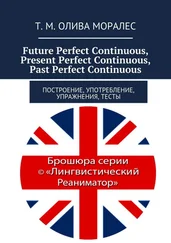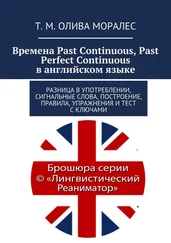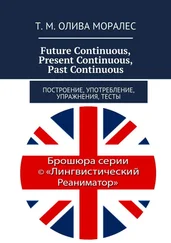James A. Jahnke - Continuous Emission Monitoring
Здесь есть возможность читать онлайн «James A. Jahnke - Continuous Emission Monitoring» — ознакомительный отрывок электронной книги совершенно бесплатно, а после прочтения отрывка купить полную версию. В некоторых случаях можно слушать аудио, скачать через торрент в формате fb2 и присутствует краткое содержание. Жанр: unrecognised, на английском языке. Описание произведения, (предисловие) а так же отзывы посетителей доступны на портале библиотеки ЛибКат.
- Название:Continuous Emission Monitoring
- Автор:
- Жанр:
- Год:неизвестен
- ISBN:нет данных
- Рейтинг книги:4 / 5. Голосов: 1
-
Избранное:Добавить в избранное
- Отзывы:
-
Ваша оценка:
- 80
- 1
- 2
- 3
- 4
- 5
Continuous Emission Monitoring: краткое содержание, описание и аннотация
Предлагаем к чтению аннотацию, описание, краткое содержание или предисловие (зависит от того, что написал сам автор книги «Continuous Emission Monitoring»). Если вы не нашли необходимую информацию о книге — напишите в комментариях, мы постараемся отыскать её.
The new edition of the only single-volume reference on both the regulatory and technical aspects of U.S. and international continuous emission monitoring (CEM) systems Continuous Emission Monitoring
Continuous Emission Monitoring:
Continuous Emission Monitoring, Third Edition
Continuous Emission Monitoring — читать онлайн ознакомительный отрывок
Ниже представлен текст книги, разбитый по страницам. Система сохранения места последней прочитанной страницы, позволяет с удобством читать онлайн бесплатно книгу «Continuous Emission Monitoring», без необходимости каждый раз заново искать на чём Вы остановились. Поставьте закладку, и сможете в любой момент перейти на страницу, на которой закончили чтение.
Интервал:
Закладка:
Code of Federal Regulation citations are given in the format: (Title) CFR (Part). For example, 40 CFR 60 refers to the part of the code where the New Source Performance Standards (NSPS) are found. Performance specification test procedures for CEM systems are found in 40 CFR 60 Appendix B(U.S. EPA 2020c). Federal Register citations are given in the format: (Volume No.) FR (Page No.) (Date). As another example, the final performance specification test procedures 1–4 were published in the Federal Register in 1975 at 40 FR 46240 10/ 6/75. CFR publications can be found on http://www.ecfr.gov. Federal Register publications can be found on http://www.govinfo.gov/app/collection/fr. Federal Register publications can be useful by providing a background behind decisions that went into a final rule. Preambles to final rules include EPA’s responses to comments submitted on the proposed rule on which the final rule is based. Most of the rules do not stand alone and refer to other rules, test methods, monitoring specifications, and quality assurance requirements in other subparts and/or appendices of the Code of Federal Regulations.
Once promulgated, implementing rules may be amended or superseded by subsequent rules. This can create some confusion, particularly when rules overlap, as has been the case with the acid rain rules of 40 CFR 75 and the New Source Performance Standards of 40 CFR 60. Because the source‐specific standards are written at different times by different people, the formats, terminology, and specifications are sometimes inconsistent between the different standards. Although there are periodic attempts to harmonize the rules, inconsistencies often remain.
New Source Performance Standards, 40 CFR 60
U.S. EPA regulations concerning stationary sources are found under Title 40 Subchapter C of the Code. Newly constructed sources are required to meet New Source Performance Standards (NSPS), which are given in Part 60 of Title 40 (expressed as 40 CFR 60). Each source category, such as the electric utilities, municipal incinerators, or cement plants, is assigned a Subpart letter (Subpart Da, Eb, and F, respectively) by which it is referred to in the CFR (U.S. EPA 2020a).
The rules prepared by this office affect newly constructed sources. A “new source” is defined as one constructed after the date the rules are first proposed in the Federal Register. An “existing source” is a source constructed before that date. Rules for existing sources are given by the individual states, usually in facility operating permits, with federal guidance and approval. The Part 60 Subparts address primarily new sources, but also include subparts that provide guidance to the states to develop rules for existing sources. When meeting the federal guidance requirements, the rules for specific source categories can be incorporated into the State Implementation Plan (SIP) (U.S. EPA 2020b). Source categories required to install CEM systems under NSPS are given in Table 2‐1.

Figure 2‐3 U.S. Rulemaking requiring CEM systems.
Table 2‐1shows the depth of CEM applications in U.S. industry and power production, but it should also be viewed as a guide to the Part 60 Subparts. The table gives applicability dates that distinguish “existing” sources from “new” and modified or reconstructed sources. The table lists those source categories required to monitor the concentration of gaseous pollutants, flue gas opacity, and/or particulate matter (PM). The table also lists the types of operational units on which a CEM system is to be installed. For example, Subpart BB for Kraft pulp mills may require monitoring on a number of devices, such as the recovery furnace, lime kiln, and digester contained within the plant. Sources such as the electric utilities or municipal waste combustors may have multiple boilers or combustors, all of which may require monitoring.
Note that most of the “effective dates” are old, and one might consider that “new” sources first affected by this program are now “old.” When Part 60 source requirements prove to be inadequate, new subparts are added to address newer “new” sources. This is the case for Subparts D and Da for electric utilities, Subparts Ea and Eb for municipal waste combustors, and Subparts J and Ja for petroleum refineries. The newer rules become more proscriptive and often require the installation of CEM systems not required in earlier subparts. Both new and existing stationary sources can be further regulated through programs such as the acid rain program of 40 CFR 75 and the air toxics program of 40 CFR 63, in addition to state permit requirements. Each of these programs can impose additional monitoring requirements.
TABLE 2‐1 Summary of New Source Performance Standards (NSPS) 40 CFR 60 CEM Requirements for Sources with Effective Dates 1971–1990
Source : Data from U.S. EPA (2020b).
| Source Category | Part 60 Subpart | Affected Units | Effective Date a , b | CEM Requirements c | CFR Monitoring Reference |
|---|---|---|---|---|---|
| Hospital/Medical/Infectious Waste Incinerators (HMIWI) | Ce SIP Guidelines | Combustor | 6/20/96 3/16/98 b | CO | 60.37e |
| Fossil‐fuel‐fired steam generators | D | Boilers > 73 MW | 8/17/71 a , b | SO 2, NO x, CO O 2or CO 2Opacity (PM CEMS option) | 60.45 |
| Electric utility steam‐generating units d | Da | Boilers > 73 MW | 9/18/78 a , b2/28/05 a , b(IGCC) | SO 2, NO x, CO O 2or CO 2Opacity PM CEMS (Options for PMCPMS, Bag Leak Detector) | 60.49Da |
| Industrial‐commercial‐ institutional steam‐generating units | Db | Boilers >29 MW < 73 MW | 6/19/84 a , b | SO 2, NO x, CO O 2or CO 2Opacity (PM CEMS Option) | 60.46b 60.47b 60.48b |
| Small industrial‐commercial‐institutional steam‐generating units | Dc | Boilers > 2.9 MW <29 MW | 6/9/89 a | SO 2Opacity | 60.46c 60.47c |
| Municipal waste combustors | Ea | Combustor | 12/20/89 | Opacity SO 2, NO x, CO | 69.56a |
| Municipal waste combustors | Eb | Combustor | 9/20/94 6/19/96 b | Opacity SO 2, NO x, CO (Options for PM HCl, Hg, D/F) | 60.58b |
| Portland cement plants | F | Kiln and clinker cooler | 8/17/71 | Opacity | 60.63 |
| HNO 3plants | G | Process equipment | 8/17/71 | NO x | 60.73 |
| HNO 3plants | Ga | Process equipment | 10/14/11 b | NO x | 60.73a |
| H 2SO 4plants | H | Process equipment | 8/17/71 | SO 2O 2, CO 2 | 60.84 |
| Petroleum refineries | J | Catalytic cracker Fuel gas combustor Claus recovery plants | 6/11/73 | Opacity, SO 2, O2, CO SO 2or H 2S TRS or SO 2O 2 | 60.105 |
| Petroleum refineries | Ja | Fluid Catalytic Cracking Units Sulfur Recovery Units Fuel Gas Combustion Process Heaters | 5/14/07 | PM, Opacity BLD CO, CO 2, O 2SO 2, NO xSO 2, TRS, H 2S O 2SO 2or H 2S O 2NO x,O 2 | 60.106a 60.106b 60.107a |
| Primary copper smelters | P | Roaster/Smelter Cu convertor Dryer | 10/16/74 | SO2 Opacity | 60.165 |
| Primary zinc smelters | Q | Sintering machine | 10/16/74 | Opacity SO 2 | 60.175 |
| Primary lead smelters | R | Blast/Reverberatory furnaces Sintering machine | 10/16/74 | Opacity Opacity SO 2 | 60.185 |
| Ferroalloy production facilities | Z | Submerged electric arc furnaces | 10/21/74 | Opacity | 60.264 |
| Steel plants | AA | Electric arc furnaces | Constructed between 10/21/74 and 8/17/83 | Opacity | 60.273 |
| Steel plants | AAa | Electric arc furnaces | 8/7/83 | Opacity | 60.273a |
| Kraft pulp mills | BB | Recovery furnace Lime kiln Digester Brown stock washer Evaporator:oxidation andstripper system | 9/24/76 | Opacity, TRS e | 60.284 |
| Glass manufacturing plants | CC | Glass melting furnace | 6/15/79 | Opacity | 60.293 |
| Stationary gas turbines | GG | 10 MBtu | Constructed between 10/3/77 to 7/8/04 | Option: NO x, O 2/CO 2 | 60.334 |
| Lime manufacturing facilities | HH | Rotary lime kiln | 5/3/77 | Opacity, or scrubber Δp & supply P | 60.343 |
| Phosphate rock plants | NN | Dryer and calciner grinder | 9/21/79 | Opacity Opacity | 60.403 |
| Tire manufacturing industry | BBB | 1/20/83 | VOC d | 60.544 | |
| Polymer industry | DDD | Carbon adsorbers | Constructed between 9/30/87 – 11/10/89 | VOC d | 60.563 |
| Flexible vinyl and urethane coating and printing | FFF | Solvent recovery controls Exhaust hoods | 1/18/83 | VOC d | 60.584 |
| Synthetic Organic Chemical Manufacturing Industry (SOCMI) | III | Air oxidation process controls Absorbers, condensers, carbon adsorbers | 10/21/83 | VOC d | 69.615 60.613 |
| Onshore natural gas processing | LLL | Sweetening units | Constructed between 1/20/84 and 8/23/11 | TRS, SO 2Velocity | 60.646 |
| SOCMI | NNN | Distillation operations | 12/30/83 | VOC d | 60.663 |
| Nonmetallic mineral processing plants | OOO | Baghouses | 4/22/08 | Particulate Matter | 60.674 |
| Petroleum refinery wastewater systems | QQQ | Carbon adsorbers | 5/4/87 | VOC | 60.694 60.695 |
| SOCMI reactor processes | RRR | Absorbers Condensers Adsorbers | 6/29/90 | VOC d | 60.703 |
| Magnetic tape coating | SSS | Carbon adsorbers | 1/22/86 | VOC d | 60.714 |
| Mineral industries | UUU | Calciners and dryers | 4/23/86 | Opacity | 60.734 |
| Polymeric coating | VVV | Carbon adsorbers | 4/30/87 | VOC d | 60.774 |
aNSPS applies if construction commenced after this date.
Читать дальшеИнтервал:
Закладка:
Похожие книги на «Continuous Emission Monitoring»
Представляем Вашему вниманию похожие книги на «Continuous Emission Monitoring» списком для выбора. Мы отобрали схожую по названию и смыслу литературу в надежде предоставить читателям больше вариантов отыскать новые, интересные, ещё непрочитанные произведения.
Обсуждение, отзывы о книге «Continuous Emission Monitoring» и просто собственные мнения читателей. Оставьте ваши комментарии, напишите, что Вы думаете о произведении, его смысле или главных героях. Укажите что конкретно понравилось, а что нет, и почему Вы так считаете.
